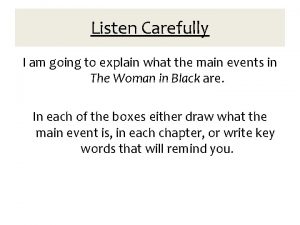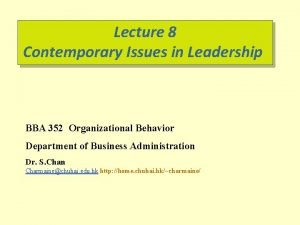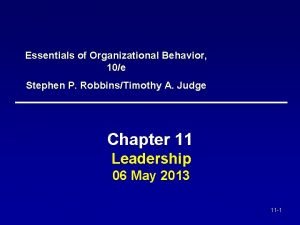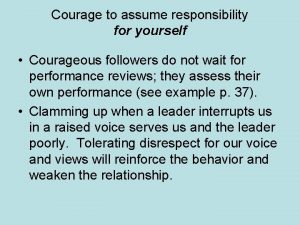The courage to listen to followers Do you







- Slides: 7

The courage to listen to followers • Do you really want courageous followers? – May say one thing, but behavior and polices encourage other behaviors from followers – Acid test: do followers actually come to you with tough issues about corporate issues or your own behavior and policies? • What messages are number twos sending? – Responsible not only for the cultural and moral tone you set personally, but also for the tone set by those with whom you surround yourself.

• Appreciating and accepting support. – Don’t micro-manage. Hire good people, give them the tools they need to do the job, then trust them to do it. • Appreciating constructive challenge more – Do you really appreciate staff who challenge the way in which you are leading? – Create a climate in which you hear and pay attention to tough feedback. • Examine your own beliefs about authority, what is and is not appropriate to say to those in authority • Reflect on your comfort with criticism

• If you react defensively when criticized, you are unlikely to hear further about the matter or to hear further from the individual. • A requisite of good leadership is to override naturally defensive feeling, statements, and behaviors, and display genuine interest in what sources of critical feedback are telling you. • Demonstrate responsiveness to feedback • Inviting creative challenge – Proactive vs. reactive – Distinguish between challenge to your authority and challenge to your ideas

– When leaders present their own ideas for action before giving their team a chance to generate a range of options, they inhibit further dialogue. – Establish norms of behavior that encourage creative challenge. • Creative processes are distinct from evaluative processes. • Sacred cows led to pasture. • Wild ideas not discounted, even sensible ideas tested against alternate scenarios

• A culture of communication, not complaints. – Complaints should be taken to the person or persons who need to be addressed for it to be resolved. – Are there complaints about you that you are not hearing? – Leaders that listen to complaints are colluding with the dysfunctional culture. – The leadership task is to build a culture in which conflict is handled through healthy and creative dialogue.

• Creating protected communication channels – Provide your staff with a low-risk way of raising issues that concern them. • Discernment: what is the right action? – Purpose driven vs. ego driven – True motives • Responding to a moral stand – Defining moment – Common (but inappropriate) response is to devalue the individuals taking the stand. – Another common response (but inappropriate) is to discount the charges.

• Good responses to a moral stand: – Separate the message from the messenger. – Promise to get back to the individual personally, and commit to a time frame for doing so. – Consult with advisors, but keep communications privileged. – Choose the course of action that best serves the common purpose. – Report back personally to the individuals or individuals with the concern. • Grow as both a leader and a follower. See the meditations on pages 221 -222













